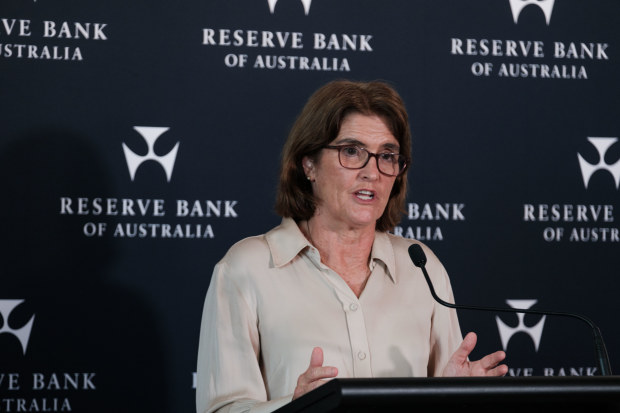RBA to watch for ‘spillover’ from aged care pay rise

The Reserve Bank will watch for spillover effects from last week’s “very worthy” aged care pay rise of up to 14 per cent for about 300,000 workers but says this is unlikely to shift forecasts for wages or inflation.
RBA governor Michele Bullock told reporters on Tuesday that although the bank had not included the Fair Work Commission’s increase in its wage growth forecasts, “I don’t think it’s going to make a measurable difference”.

RBA governor Michele Bullock says it’s “a very worthy pay rise” for the aged care sector. Oscar Colman
“We might want to watch to see if there are some spillovers, but I’m not expecting that it’s going to have a great impact,” she said.
The Reserve Bank board said wage growth appeared to have peaked last year at 4.2 per cent but that this would remain consistent with inflation only if productivity increased to its long-run average.
Last week, the FWC awarded about 250,000 personal carers pay rises of between 2 per cent and 13.5 per cent to tackle the gendered undervaluation of their work. Cleaners, cooks and laundry hands in the aged care sector also won pay rises of 7 per cent.
Some warned the pay rise for cleaners and cooks in aged care could attract labour from other sectors, lifting wage pressures in those areas or forcing businesses to deal with fewer workers.
National Australia Bank economist Taylor Nugent expected the increase to make a “similar contribution” to overall wage growth as last year’s 15 per cent aged care increase, or about 0.2 percentage points at year-end.
“Some of the numbers [in the increases] are a little bit smaller but you’ve also got broader scope for cleaners and those marginally attached to aged care,” he said.
NAB has forecast annual wage growth of 3.9 per cent in the third quarter; the RBA has forecast it to drop to 3.7 per cent by December.
Mr Nugent said the aged care increase, public sector wage deals and private sector collective agreements would help keep the wage market strong.
“Broadly we think we will be around these levels [of about 4 per cent] on a year-on-year level for a few months,” he said.
A spokesman for Downer, which owns cleaning giant Spotless, said it “does not expect this decision by the FWC to have an immediate impact on our ability to attract and retain cleaners in other sectors”.
“However, Downer will continue to monitor all factors that have the potential to impact labour availability.”
‘Historically underpaid’
Ms Bullock said: “I don’t think anyone would begrudge aged care workers a rise.
“They’ve been historically underpaid for the work they do. It’s a very important job. And there’s shortages in those industries. So I think it’s a very worthy pay rise.”
Aged care consultancy StewartBrown partner David Sinclair said his broad estimate was the increase would cost the federal budget $3.3 billion over the next four years, in contrast to the $11.3 billion for the last increase.
The 7 per cent increase for hospitality and 3 per cent for other indirect carers made up $830 million of that total.
However, he said there was too much up in the air to give a specific calculation, given the commission had introduced a whole new wage structure with about 20 new classifications.
“The complexity at the moment is the variations in the pay increases depend on positions [in the new classification], so it’s difficult to estimate the cost. As more details arise then we can establish a more accurate estimate.”
RMIT emeritus professor Sara Charlesworth said the FWC decision could have ramifications for other carer jobs where minimum rates had been fixed with gendered assumptions.
“The commission found that caring work is different work [from male-dominated work],” she said. “They hinted in their decision that this may be relevant in other care sectors, think early childhood education and care, the children services award, the disability support workforce.”
The commission is already considering further pay rises for nurses and has signalled that degree-qualified registered nurses should get a benchmark rate of $1470 a week, a 13 per cent increase from the current minimum rate.
Subscribe to gift this article
Gift 5 articles to anyone you choose each month when you subscribe.
Subscribe nowAlready a subscriber?
Introducing your Newsfeed
Follow the topics, people and companies that matter to you.
Find out moreRead More
Latest In Workplace
Fetching latest articles